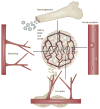HCC and angiogenesis: possible targets and future directions
- PMID: 21386818
- PMCID: PMC3266719
- DOI: 10.1038/nrclinonc.2011.30
HCC and angiogenesis: possible targets and future directions
Erratum in
- Nat Rev Clin Oncol. 2011 May;8(5):302
Abstract
Hepatocellular carcinoma (HCC), the most common primary liver tumor, is notoriously resistant to systemic therapies, and often recurs even after aggressive local therapies. HCCs rely on the formation of new blood vessels for growth, and VEGF is critical in this process. A hallmark of new vessel formation in tumors is their structural and functional abnormality. This leads to an abnormal tumor microenvironment characterized by low oxygen tension. The liver is perfused by both arterial and venous blood and the resulting abnormal microenvironment selects for more-aggressive malignancies. Anti-VEGF therapy with sorafenib was the first systemic therapy to demonstrate improved survival in patients with advanced-stage HCC. This important development in the treatment of HCC raises hope as well as critical questions on the future development of targeted agents including other antiangiogenic agents, which hold promise to further increase survival in this aggressive disease.
Conflict of interest statement
A. X. Zhu declares associations with the following companies: Bayer, Novartis, Pfizer, Sanofi-Aventis. R. K. Jain declares associations with the following companies: Astellas, AstraZeneca, Dyax, Fibrogen, Genzyme, MedImmune, MorphoSys, Noxxon, Regeneron, SynDevRx. See the article online for full details of the relationships. The other authors declare no competing interests.
Figures

References
-
- Ferlay J, et al. Estimates of worldwide burden of cancer in 2008: GLOBOCAN 2008. Int J Cancer. 2010;127:2893–2917. - PubMed
-
- Thomas MB, Zhu AX. Hepatocellular carcinoma: the need for progress. J Clin Oncol. 2005;23:2892–2899. - PubMed
-
- Fong Y, Kemeny N, Lawrence TS. In: Cancer, Principles and Practice of Oncology. 6. DeVita VT, Hellman S, Rosenberg SA, editors. Lippincott Williams and Wilkins; Philadelphia, PA, USA: 2001. pp. 1162–1203.
-
- Folkman J. Angiogenesis: an organizing principle for drug discovery? Nat Rev Drug Discov. 2007;6:273–286. - PubMed
-
- Van de Veire S, et al. Further pharmacological and genetic evidence for the efficacy of PlGF inhibition in cancer and eye disease. Cell. 2010;141:178–190. - PubMed
Publication types
MeSH terms
Substances
Grants and funding
LinkOut - more resources
Full Text Sources
Other Literature Sources
Medical

